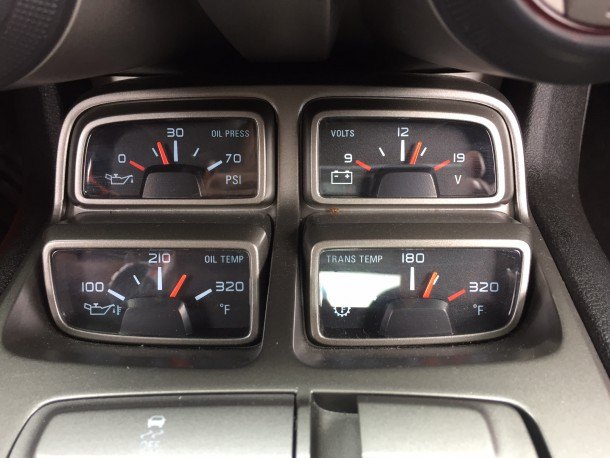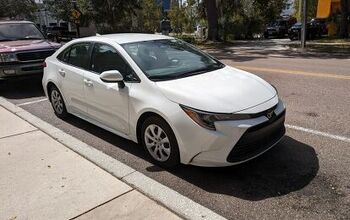2015 Chevrolet Camaro SS Track Test
It is truly a great time to be a gearhead. Not in the sense of there are no bad cars, because there still are, but rather because the cars that are good are really damn good. Take for example this Camaro SS. For three days, I lapped it around the freshly repaved tarmac of Gingerman Raceway in South Haven, Michigan.
Currently GM offers six versions of the Camaro, from the relatively mild-mannered 323 horsepower 3.6 liter V-6, to the journalist jailing supercharged 580 HP ZL1. This doesn’t include the nearly 17 convertible and specialty variants. This particular Summit White version is a 2SS model with leather interior, a 426 hp 6.2 liter V-8 and 6 speed automatic transmission. Building this car on Chevy’s website comes in a hair under $40K.
Slipping into the wide leather seats, the Camaro immediately reveals its size. It’s not a big car but quite portly at around 4,000 lbs and it feels like it with the over-boosted power steering and long travel brake pedal. That’s not a complete negative because the reality of this car is it will spend it’s life on a daily commuter’s grind with an occasional stoplight blast to remind the owner they bought the V-8.
However, the track is where the Camaro surprises you. Even with the over-boosted steering and marshmallow power brakes, the Camaro can actually handle itself on a track. In the first turn the SS seems to magically shed 1,000 lbs. It is by no means a track car, but becomes unexpectedly nimble. Where the overbuilt nature of the Camaro comes into play is its ability to repeat this activity for three straight days.
The first trick, of course, is to completely disable the traction control. Either hold the button or press it twice to completely turn it off, otherwise the yaw control will apply the brakes. It won’t upset the car, but it will add wear to the almost overtasked four-wheel discs.
Instead, you learn to use the tires, but be warned that those tires will not last. The SS comes from the Oshawa plant equipped with staggered P245/45R20 front and P275/40R20 rear high-performance summer tires. These are capable shoes, especially in the light of the Camaro’s most likely fate. However, if you are in the market for this and you’re going hit the track, invest in a spare set of rims and tires. This is no different than with the Mustang GT or even the Challenger — they are all fast cars, but they are not Miatas and will consume wear items. Even harking back to their earliest appearances in the late ’60s Trans-Am series, track versions of these cars need upgraded shoes and brakes. Fortunately, there is a host of companies, including GM Performance, that make this an entertaining late night Internet search and endless fodder for web forum debates and bench races.
Alongside those debates about the best wheels, tires and the worthiness of a GM brake system versus a Wildwood upgrade, you will see discussions on engine enhancements. You don’t need them. The 6.2 LS, even in this form, is plenty. You won’t set any track records, but the 420-foot pounds of torque is more than enough to put you in well over your head.
Leading a pack of supercars could be overwhelming, yet a well-driven SS managed to hold its own. The car would push through turn 2 but slide right onto the outside for a blast into turn 3. With a suspension load, the SS would use the whole track for exit then build a solid head of steam through 4 without lifting and settling on the outside of the entry into 5. Turn 6 was the Camaro’s moneymaker. The trick was to take the exit of 5 all the way to the far side for the 6 entry, hit the apex and roll into the throttle hard. Let the rear wheels spin through the limited slip, stepping the rear slightly out, and glide to the exit. Without fail, this would put a car length on the aggressively driven Nissan GT-R following behind. The right sweeper of turn 7 would give the AWD cars a chance to catch as the Camaro pushed the front end to drive to the outside, but the SS would be impossibly well composed and balanced through the 8/9 combo. Hard into 10a with a hint of trail braking and before letting the big dog run down the the Phoenix Flat, textbook entry for turn 11 and onto the front straight, hard braking up the hill for turn 1.
Wash. Rinse. Repeat. This would be the SS’s job for three straight days. That is actually where you begin to respect the Camaro. Yes, there are lots of well-built cars that you can drive to the track, enjoy all weekend and drive home, but the SS was here to lead a pack of 9 supercars totaling almost 4,500 horsepower — five of them equipped with all-wheel drive. This was a real trial for the big white whale, and it was honestly up to the task. It is not a supercar. It is just a solid, fast car.
If you have 40 grand and a need for the occasional backseat you could do worse than the Camaro. Staying out of the option box could keep the cost closer to $35K. That would leave you some room for the modifications you would eventually make. After all, you’re a gearhead, and it’s a great time to be one.
General Motors contributed nothing to this review.
Christian “Mental” Ward has owned over 70 cars and destroyed most of them. He is married to the most patient woman in the world, lives in Atlanta and is racing his a tape covered Honda Civic in the 24 Hours of LeMons this month at Autobahn in Joilet Illinois. You can follow that and all his other shenaningans on Instagram, Twitter and Vine at M3ntalward.
School teacher, amateur racer, occasional story teller.
More by W Christian Mental Ward
Latest Car Reviews
Read moreLatest Product Reviews
Read moreRecent Comments
- Redapple2 Love the wheels
- Redapple2 Good luck to them. They used to make great cars. 510. 240Z, Sentra SE-R. Maxima. Frontier.
- Joe65688619 Under Ghosn they went through the same short-term bottom-line thinking that GM did in the 80s/90s, and they have not recovered say, to their heyday in the 50s and 60s in terms of market share and innovation. Poor design decisions (a CVT in their front-wheel drive "4-Door Sports Car", model overlap in a poorly performing segment (they never needed the Altima AND the Maxima...what they needed was one vehicle with different drivetrain, including hybrid, to compete with the Accord/Camry, and decontenting their vehicles: My 2012 QX56 (I know, not a Nissan, but the same holds for the Armada) had power rear windows in the cargo area that could vent, a glass hatch on the back door that could be opened separate from the whole liftgate (in such a tall vehicle, kinda essential if you have it in a garage and want to load the trunk without having to open the garage door to make room for the lift gate), a nice driver's side folding armrest, and a few other quality-of-life details absent from my 2018 QX80. In a competitive market this attention to detai is can be the differentiator that sell cars. Now they are caught in the middle of the market, competing more with Hyundai and Kia and selling discounted vehicles near the same price points, but losing money on them. They invested also invested a lot in niche platforms. The Leaf was one of the first full EVs, but never really evolved. They misjudged the market - luxury EVs are selling, small budget models not so much. Variable compression engines offering little in terms of real-world power or tech, let a lot of complexity that is leading to higher failure rates. Aside from the Z and GT-R (low volume models), not much forced induction (whether your a fan or not, look at what Honda did with the CR-V and Acura RDX - same chassis, slap a turbo on it, make it nicer inside, and now you can sell it as a semi-premium brand with higher markup). That said, I do believe they retain the technical and engineering capability to do far better. About time management realized they need to make smarter investments and understand their markets better.
- Kwik_Shift_Pro4X Off-road fluff on vehicles that should not be off road needs to die.
- Kwik_Shift_Pro4X Saw this posted on social media; “Just bought a 2023 Tundra with the 14" screen. Let my son borrow it for the afternoon, he connected his phone to listen to his iTunes.The next day my insurance company raised my rates and added my son to my policy. The email said that a private company showed that my son drove the vehicle. He already had his own vehicle that he was insuring.My insurance company demanded he give all his insurance info and some private info for proof. He declined for privacy reasons and my insurance cancelled my policy.These new vehicles with their tech are on condition that we give up our privacy to enter their world. It's not worth it people.”













































Comments
Join the conversation
"Even harking back to their earliest appearances in the late ’60s Trans-Am series, track versions of these cars need upgraded shoes and brakes." They also had acid-dipped bodies to save weight, a Traco 460 hp 5 liter V8, suspension redone and all new brakes, no upholstery, a roll cage, etc. I saw these things when I attended St Jovite TransAm in '68 when Mark Donahue won. It was a cheater car by the master, Roger the Dodger Penske. I don't recall any street Camaros at the race. Various hopefuls campaigned Minis (yes!) Alfas and 911s, and they just got in the way. I bet one of these resurrected Penske Camaros just with modern tires would eat this fatty Camaro for breakfast, and be looking for a snack by 0945. Cart springs and all. In fact, the Mustangs and Javelins would too. These cars only weighed 2600 lbs or so, and decently quick. Here is a huge pile of pix from that very race: http://www.camaros.org/forum/index.php?topic=9992.0
Not bad for the base SS comfortable old man edition. Anyone who tracks would definitely want to tick the 1LE option box. I really like that 1LE and if you read the rags the new Mustang still cant touch it for the folks who value handling over ride comfort. So there is a cheap interior and it weighs alot and you cant see out of it. But what is the alternative if you want bad ass handling v8 car at a reasonable price. The chevy SS sedan is close but more dough. The Mustang still cant hang and the challenger is a big old marshamallow. Maybe the new Camaro will be just that much better. Im all for smaller and lighter, i think what i am envisioning is a modern LX 5.0 notch LOL.